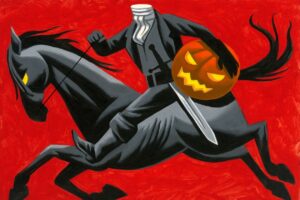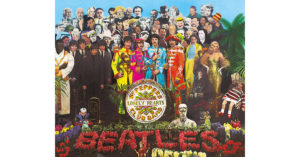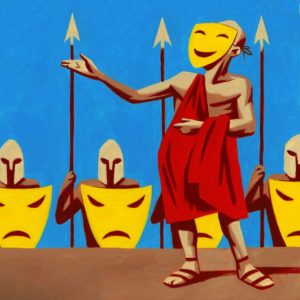From Homer to Edgar Allan Poe, ghost stories have given us a chilling good time
October 23, 2020
As the novelist Neil Gaiman, a master of the macabre, once said, “Fear is a wonderful thing, in small doses.” In this respect, we’re no different than our ancestors: They, too, loved to tell ghost stories.
One of the earliest ghosts in literature appears in Homer’s Odyssey. Odysseus entertains King Alcinous of Phaeacia with an account of his trip to the Underworld, where he met the spirits of Greek heroes killed in the Trojan War. The dead Achilles complains that being a ghost is no fun: “I should choose, so I might live on earth, to serve as the hireling of another…rather than to be lord over all the dead.”

ILLUSTRATION: THOMAS FUCHS
It was a common belief in both Eastern and Western societies that ghosts could sometimes return to right a great wrong, such as an improper burial. The idea that ghosts are intrinsically evil—the core of any good ghost story—received a boost from Plato, who believed that only wicked souls hang on after death; the good know when it’s time to let go.
Ghosts were problematic for early Christianity, which taught that sinners went straight to Hell; they weren’t supposed to be slumming it on Earth. The ghost story was dangerously close to heresy until the Church adopted the belief in Purgatory, a realm where the souls of minor sinners waited to be cleansed. The Byland Abbey tales, a collection of ghost stories recorded by an anonymous 15th-century English monk, suggest that the medieval Church regarded the supernatural as a useful form of advertising: Not paying the priest to say a mass for the dead could lead to a nasty case of haunting.
The ghost story reached its apogee in the early modern era with Shakespeare’s “Hamlet,” which opens with a terrified guard seeing the ghost of the late king on the battlements of Elsinore Castle. But the rise of scientific skepticism made the genre seem old-fashioned and unsophisticated. Ghosts were notably absent from English literature until Horace Walpole, son of Britain’s first prime minister, published the supernatural mystery novel “The Castle of Otranto” in 1764, as a protest against the deadening effect of “reason” on art.
Washington Irving was the first American writer to take the ghost story seriously, creating the Headless Horseman in his 1820 tale “The Legend of Sleepy Hollow.” He was a lightweight, however, compared with Edgar Allan Poe, who turned horror into an art form. His famous 1839 story “The Fall of the House of Usher” heightens the tension with ambiguity: For most of the story, it isn’t clear whether Roderick Usher’s house really is haunted, or if he is merely “enchained by certain superstitious impressions.”
Henry James used a similar technique in 1895, when, unhappy with the tepid reception of his novels in the U.S., he decided to frighten Americans into liking him. The result was the psychological horror story “The Turn of the Screw,” about a governess who may or may not be seeing ghosts. The reviews expressed horror at the horror, with one critic describing it as “the most hopelessly evil story that we could have read in any literature.” With such universal condemnation, success was assured.








